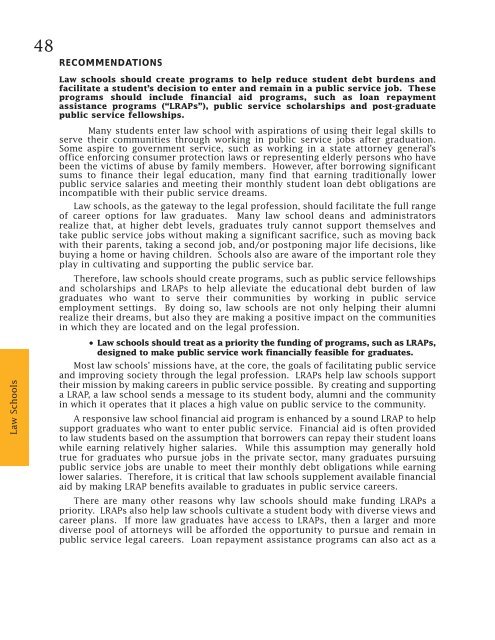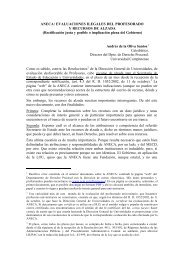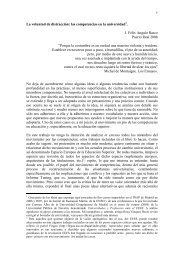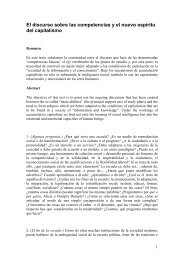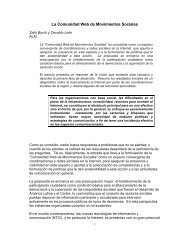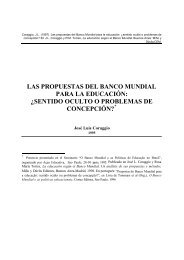Lifting the Burden: Law Student Debt as a Barrier to Public Service
Lifting the Burden: Law Student Debt as a Barrier to Public Service
Lifting the Burden: Law Student Debt as a Barrier to Public Service
Create successful ePaper yourself
Turn your PDF publications into a flip-book with our unique Google optimized e-Paper software.
48RECOMMENDATIONS<strong>Law</strong> schools should create programs <strong>to</strong> help reduce student debt burdens andfacilitate a student’s decision <strong>to</strong> enter and remain in a public service job. Theseprograms should include financial aid programs, such <strong>as</strong> loan repayment<strong>as</strong>sistance programs (“LRAPs”), public service scholarships and post-graduatepublic service fellowships.Many students enter law school with <strong>as</strong>pirations of using <strong>the</strong>ir legal skills <strong>to</strong>serve <strong>the</strong>ir communities through working in public service jobs after graduation.Some <strong>as</strong>pire <strong>to</strong> government service, such <strong>as</strong> working in a state at<strong>to</strong>rney general’soffice enforcing consumer protection laws or representing elderly persons who havebeen <strong>the</strong> victims of abuse by family members. However, after borrowing significantsums <strong>to</strong> finance <strong>the</strong>ir legal education, many find that earning traditionally lowerpublic service salaries and meeting <strong>the</strong>ir monthly student loan debt obligations areincompatible with <strong>the</strong>ir public service dreams.<strong>Law</strong> schools, <strong>as</strong> <strong>the</strong> gateway <strong>to</strong> <strong>the</strong> legal profession, should facilitate <strong>the</strong> full rangeof career options for law graduates. Many law school deans and administra<strong>to</strong>rsrealize that, at higher debt levels, graduates truly cannot support <strong>the</strong>mselves andtake public service jobs without making a significant sacrifice, such <strong>as</strong> moving backwith <strong>the</strong>ir parents, taking a second job, and/or postponing major life decisions, likebuying a home or having children. Schools also are aware of <strong>the</strong> important role <strong>the</strong>yplay in cultivating and supporting <strong>the</strong> public service bar.Therefore, law schools should create programs, such <strong>as</strong> public service fellowshipsand scholarships and LRAPs <strong>to</strong> help alleviate <strong>the</strong> educational debt burden of lawgraduates who want <strong>to</strong> serve <strong>the</strong>ir communities by working in public serviceemployment settings. By doing so, law schools are not only helping <strong>the</strong>ir alumnirealize <strong>the</strong>ir dreams, but also <strong>the</strong>y are making a positive impact on <strong>the</strong> communitiesin which <strong>the</strong>y are located and on <strong>the</strong> legal profession.<strong>Law</strong> Schools• <strong>Law</strong> schools should treat <strong>as</strong> a priority <strong>the</strong> funding of programs, such <strong>as</strong> LRAPs,designed <strong>to</strong> make public service work financially fe<strong>as</strong>ible for graduates.Most law schools’ missions have, at <strong>the</strong> core, <strong>the</strong> goals of facilitating public serviceand improving society through <strong>the</strong> legal profession. LRAPs help law schools support<strong>the</strong>ir mission by making careers in public service possible. By creating and supportinga LRAP, a law school sends a message <strong>to</strong> its student body, alumni and <strong>the</strong> communityin which it operates that it places a high value on public service <strong>to</strong> <strong>the</strong> community.A responsive law school financial aid program is enhanced by a sound LRAP <strong>to</strong> helpsupport graduates who want <strong>to</strong> enter public service. Financial aid is often provided<strong>to</strong> law students b<strong>as</strong>ed on <strong>the</strong> <strong>as</strong>sumption that borrowers can repay <strong>the</strong>ir student loanswhile earning relatively higher salaries. While this <strong>as</strong>sumption may generally holdtrue for graduates who pursue jobs in <strong>the</strong> private sec<strong>to</strong>r, many graduates pursuingpublic service jobs are unable <strong>to</strong> meet <strong>the</strong>ir monthly debt obligations while earninglower salaries. Therefore, it is critical that law schools supplement available financialaid by making LRAP benefits available <strong>to</strong> graduates in public service careers.There are many o<strong>the</strong>r re<strong>as</strong>ons why law schools should make funding LRAPs apriority. LRAPs also help law schools cultivate a student body with diverse views andcareer plans. If more law graduates have access <strong>to</strong> LRAPs, <strong>the</strong>n a larger and morediverse pool of at<strong>to</strong>rneys will be afforded <strong>the</strong> opportunity <strong>to</strong> pursue and remain inpublic service legal careers. Loan repayment <strong>as</strong>sistance programs can also act <strong>as</strong> a


